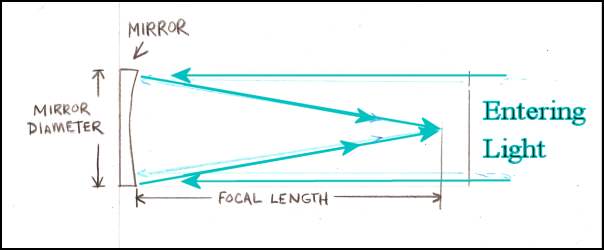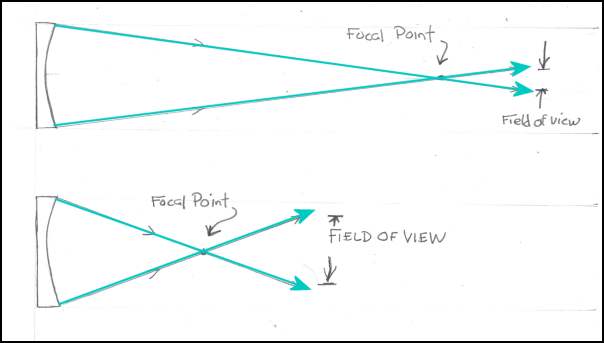How Fast is Your Telescope?
An explanation of the f/ratio of telescopes
The f ratio of telescopes is very important. It makes a difference in the size of a telescope and the viewing that can be done with it. In this article I explain what the f ratio of a telescope is all about. And telescopes are designed with a specific f ratio depending on how they are intended to be used. A short f ratio is good for viewing large areas of the sky. These are called rich field telescopes. And long focus telescopes are much better suited for viewing the planets.
Okay, first off let me explain what the f ratio number of a telescope is and how it is defined. Take a look at the picture below. It shows starlight entering a telescope and bouncing off the mirror. The shape of the mirror (parabola) redirects the light toward a point of focus The distance to this focal point is called the focal length.

Now let’s calculate the f ratio. It is simply the focal length of the mirror divided by the diameter of the mirror. So if our mirror is 6 inches wide and its focal point is thirty-six inches away we divide 36 by 6 and get an f ratio of 6. So the f ratio of such a telescope would be 6. or f6. If the focal length of this telescope were 48 inches then 48 divided by 6 would be 8 or f8.
So, what does this matter to us? This f ratio makes a big difference in how the telescope views the sky and how well you can see various objects. To explain this here is another picture and in this picture we go beyond the focal point and enter into the area that the eyepiece is placed. This is the field of view.

The two telescopes pictured above show a long focal length telescope above and a short focal length telescope below. Notice the big difference in the field of view. This shows us that when we place an eyepiece in the field of view and take a look that in the lower telescope we see more of the sky in one view. And in the upper telescope we see less of the sky. This is important, and a telescope as shown in the one on the bottom of the image is often called a Rich Field Telescope or RFT. Typically a short focus telescope like this is great for looking at scattered items in the sky such as constellations and nebulae.
So what should we take away from this lesson in f ratio? A telescope is better at viewing some things more than other things based on the f ratio. A telescope with a short f ratio (usually f4 or f5) is considered a rich field telescope and is suited for viewing the skies in wide views such as constellations, nebulae, clusters and other rich, scattered items. A telescope with a medium f ratio (usually f6 to f8) is considered a good all purpose telescope f ratio. And when the f ratio gets to be longer (f9 or higher) it is often a specialized telescope that is used for planetary viewing. This long focus is great for planetary viewing because it focuses more of the light from this small area into the eyepiece and gives better viewing and resolution.
